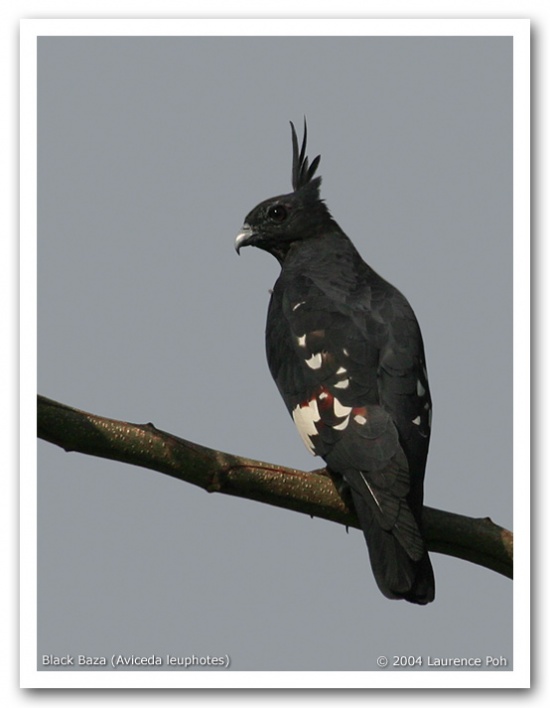m |
(Picture captions. References updated) |
||
| (11 intermediate revisions by 6 users not shown) | |||
| Line 1: | Line 1: | ||
| − | + | [[Image:Black_Baza.jpg|thumb|550px|right|Subspecies ''syama''<br /> Photo by the late '''[http://www.birdforum.net/gallery/showgallery.php/ppuser/951/cat/500 Laurence Poh]'''<br />[[Kinta Nature Park]], Batu Gajah, [[Malaysia]], January 2004]] | |
| − | [[Image:Black_Baza.jpg|thumb| | + | ;[[:Category:Aviceda|Aviceda]] leuphotes |
| − | |||
| − | |||
==Identification== | ==Identification== | ||
| − | + | 33cm (13 in)<br /> | |
| − | + | A largely black raptor with a long crest. Broad white band across upper breast, rest of underparts black-and-chestnut barred. Upperparts variably marked with chestnut and white.<br /> | |
| − | + | '''Female''' similar to male but lacks white on secondaries. <br /> | |
| − | + | '''Juvenile'' also similar but duller overall and with white streaks on throat. Broad and rounded wings, moderately long tail. <br /> | |
| − | + | ==Distribution== | |
| + | Southern [[Asia]]. Breeds in the foothills of the [[Himalayas]] and east across [[Burma]] and southern [[China]] to Hainan. In winter also found in SW [[India]] (Western Ghats), Indochina to [[Malaysia]], [[Sumatra]] and less commonly to western [[Java]]. Recorded in [[Sri Lanka]]. | ||
| − | + | Northern birds migrate through [[Indochina]] and the [[Malay Peninsula]] to [[Sumatra]]. | |
| + | [[Image:43317Blk Baza in Flight 90.JPG|thumb|350px|right|Photo by {{user|kctsang|kctsang}}<br />[[Singapore]], January 2007]] | ||
| + | ==Taxonomy== | ||
| + | ====Subspecies==== | ||
| + | Usually four subspecies are recognized<sup>[[#References|[1]]]</sup>: | ||
| + | *''A. l. wolfei'' in Sichuan; | ||
| + | *''A. l. syama'' widespread from North-eastern [[India]], Eastern [[Nepal]] to southern [[China]]; | ||
| + | *''A. l. leuphotes'' Kerala, Southern [[Burma]] and [[Thailand]]; | ||
| + | *''A. l. andamanica'' [[Andaman Islands]]; | ||
| − | + | ''Wolfei'' is sometimes considered to belong to ''syama''. Birds from Burma are sometimes placed in ''burmana''. Some authors even question the validity of ''syama''. More study needed for clarification. | |
| + | ==Habitat== | ||
| + | Open evergreen or deciduous forest. This species is often found around clearings or wide streams, sometimes near villages. From the lowlands up to 1000m. | ||
| + | ==Behaviour== | ||
| + | ====Action==== | ||
| + | Reminiscent of a corvid in flight. | ||
| + | ====Breeding==== | ||
| + | Only little known about breeding. March to May in [[Burma]], February to June in South-western India, April to June in North-eastern [[India]]. The nest is quite small and placed high in a tree, often near water. Lays 2-3 eggs which are incubated by both sexes. | ||
| + | ====Diet==== | ||
| + | Feeds on large insects, mostly grasshoppers. Takes also lizards and frogs, sometimes small birds or mammals. Perch hunting, mostly at dawn or dusk or when overcast. Known also to hunt in groups. <br /> | ||
| + | ==References== | ||
| + | #{{Ref-Clements6thAug15}} | ||
| + | {{ref}} | ||
==External Links== | ==External Links== | ||
| − | + | {{GSearch|Aviceda+leuphotes}} | |
| − | [[Category: | + | |
| + | [[Category:Birds]][[Category:Aviceda]] | ||
Revision as of 19:19, 22 August 2015

Photo by the late Laurence Poh
Kinta Nature Park, Batu Gajah, Malaysia, January 2004
- Aviceda leuphotes
Identification
33cm (13 in)
A largely black raptor with a long crest. Broad white band across upper breast, rest of underparts black-and-chestnut barred. Upperparts variably marked with chestnut and white.
Female similar to male but lacks white on secondaries.
'Juvenile also similar but duller overall and with white streaks on throat. Broad and rounded wings, moderately long tail.
Distribution
Southern Asia. Breeds in the foothills of the Himalayas and east across Burma and southern China to Hainan. In winter also found in SW India (Western Ghats), Indochina to Malaysia, Sumatra and less commonly to western Java. Recorded in Sri Lanka.
Northern birds migrate through Indochina and the Malay Peninsula to Sumatra.
Taxonomy
Subspecies
Usually four subspecies are recognized[1]:
- A. l. wolfei in Sichuan;
- A. l. syama widespread from North-eastern India, Eastern Nepal to southern China;
- A. l. leuphotes Kerala, Southern Burma and Thailand;
- A. l. andamanica Andaman Islands;
Wolfei is sometimes considered to belong to syama. Birds from Burma are sometimes placed in burmana. Some authors even question the validity of syama. More study needed for clarification.
Habitat
Open evergreen or deciduous forest. This species is often found around clearings or wide streams, sometimes near villages. From the lowlands up to 1000m.
Behaviour
Action
Reminiscent of a corvid in flight.
Breeding
Only little known about breeding. March to May in Burma, February to June in South-western India, April to June in North-eastern India. The nest is quite small and placed high in a tree, often near water. Lays 2-3 eggs which are incubated by both sexes.
Diet
Feeds on large insects, mostly grasshoppers. Takes also lizards and frogs, sometimes small birds or mammals. Perch hunting, mostly at dawn or dusk or when overcast. Known also to hunt in groups.
References
- Clements, J. F., T. S. Schulenberg, M. J. Iliff, D. Roberson, T. A. Fredericks, B. L. Sullivan, and C. L. Wood. 2015. The eBird/Clements checklist of birds of the world: v2015, with updates to August 2015. Downloaded from http://www.birds.cornell.edu/clementschecklist/download/
Recommended Citation
- BirdForum Opus contributors. (2024) Black Baza. In: BirdForum, the forum for wild birds and birding. Retrieved 20 April 2024 from https://www.birdforum.net/opus/Black_Baza




